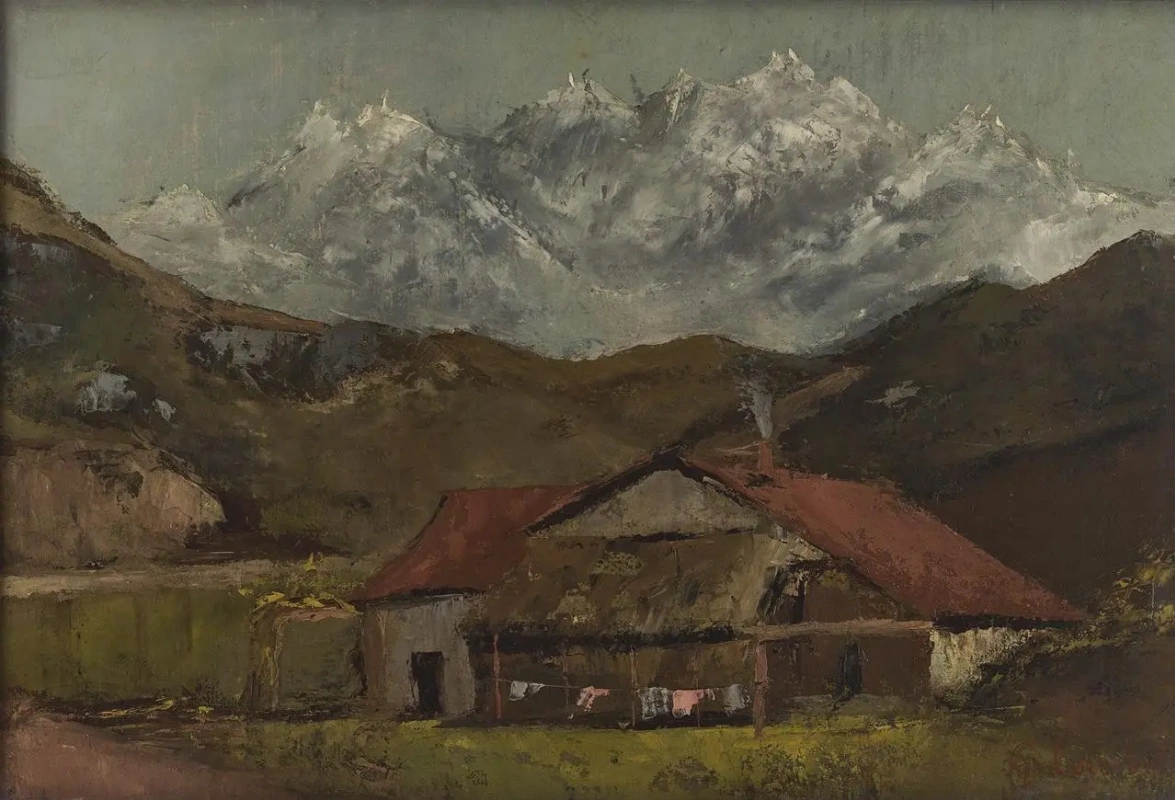log in
Enter site
Login to use Arthive functionality to the maximum
A Hut in The Mountains
Gustave Courbet • Painting, 1874, 33×49 cm


















Description of the artwork «A Hut in The Mountains»
«Sometimes he painted landscapes that nobody else could have done, the landscapes where snow could lay on», a British art critic John Berger said about Courbet. Paul Cézanne called Courbet «a bricklayer» and said that he was “as great as Michelangelo.” Courbet was even more laconic: "I paint like God Himself."
The Frenchman is certainly well known not only for his paintings but for his way of living as well. He was vain and boastful. He was much more proud of his folksy origins than of some State honors. He cannot be imagined without a beer, a smoking pipe and a cloud of smoke out of which he has been loudly, with a village vigour, theorizing about Realism and demanding to step down on earth to find the beauty literally beneath one’s feet. Well, boasting is boasting but Courbet can truly be compared to Michelangelo. His landscapes resemble sculptures, even if they don’t feature mountains, rocks and boulders. They seem to be carved of stone or moulded rather than painted. Just come look at “The Wave” by Courbet, kept here at Pushkin Museum as well, to catch it.
However, in contrast to Michelangelo, Courbet believed that an artist should not “cut the redundant out” but should depict everything as it is in real life instead. If there are no luxurious velvet draperies in front of an artist but a hanging laundry, that’s the subject one should render on canvas.
“A Hut in The Mountains” is considered one of the best Alpine landscapes of Courbet. The painting was executed in Switzerland. The point is that Gustave Courbet had so many powers that he used them both in art revolutions and in Paris Commune. When the French government, refused by the Commune, re-established its authority, Courbet was convicted for destruction of the Vendôme Column, sentenced to six months in prison and later ordered to pay a huge fine for it. He could never pay, and was forced to flee to Switzerland where he died soon after.
So, what about God? Do we have any reasons to compare Courbet to the Creator who made the world by His own will, instead of replicating an already established structure with an accuracy and obedience? Well, there seemed to be every reason for it. While Courbet was calling for the work at plein air and praised the uncompromised honesty in reconstructing the nature on the canvas, he himself painted some of his landscapes at the studio, sometimes from memory, sometimes from imagination. He was being seduced by spectacular natural phenomena including sea storms with a glowing sunset in the background. Moreover, he has been raising the brightness and contrast in his realistic landscape paintings to the level of postcards. The audience liked such color and Courbet was not willing to ignore public taste and demand. Just have a look at his landscape painting “The Sea” kept at Pushkin Museum as well. It’s one of those that viewers liked. It’s an author replica of the canvas painted near Montpellier.
Author: Natalia Kandaurova
The Frenchman is certainly well known not only for his paintings but for his way of living as well. He was vain and boastful. He was much more proud of his folksy origins than of some State honors. He cannot be imagined without a beer, a smoking pipe and a cloud of smoke out of which he has been loudly, with a village vigour, theorizing about Realism and demanding to step down on earth to find the beauty literally beneath one’s feet. Well, boasting is boasting but Courbet can truly be compared to Michelangelo. His landscapes resemble sculptures, even if they don’t feature mountains, rocks and boulders. They seem to be carved of stone or moulded rather than painted. Just come look at “The Wave” by Courbet, kept here at Pushkin Museum as well, to catch it.
However, in contrast to Michelangelo, Courbet believed that an artist should not “cut the redundant out” but should depict everything as it is in real life instead. If there are no luxurious velvet draperies in front of an artist but a hanging laundry, that’s the subject one should render on canvas.
“A Hut in The Mountains” is considered one of the best Alpine landscapes of Courbet. The painting was executed in Switzerland. The point is that Gustave Courbet had so many powers that he used them both in art revolutions and in Paris Commune. When the French government, refused by the Commune, re-established its authority, Courbet was convicted for destruction of the Vendôme Column, sentenced to six months in prison and later ordered to pay a huge fine for it. He could never pay, and was forced to flee to Switzerland where he died soon after.
So, what about God? Do we have any reasons to compare Courbet to the Creator who made the world by His own will, instead of replicating an already established structure with an accuracy and obedience? Well, there seemed to be every reason for it. While Courbet was calling for the work at plein air and praised the uncompromised honesty in reconstructing the nature on the canvas, he himself painted some of his landscapes at the studio, sometimes from memory, sometimes from imagination. He was being seduced by spectacular natural phenomena including sea storms with a glowing sunset in the background. Moreover, he has been raising the brightness and contrast in his realistic landscape paintings to the level of postcards. The audience liked such color and Courbet was not willing to ignore public taste and demand. Just have a look at his landscape painting “The Sea” kept at Pushkin Museum as well. It’s one of those that viewers liked. It’s an author replica of the canvas painted near Montpellier.
Author: Natalia Kandaurova


